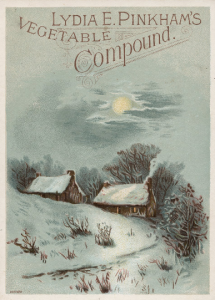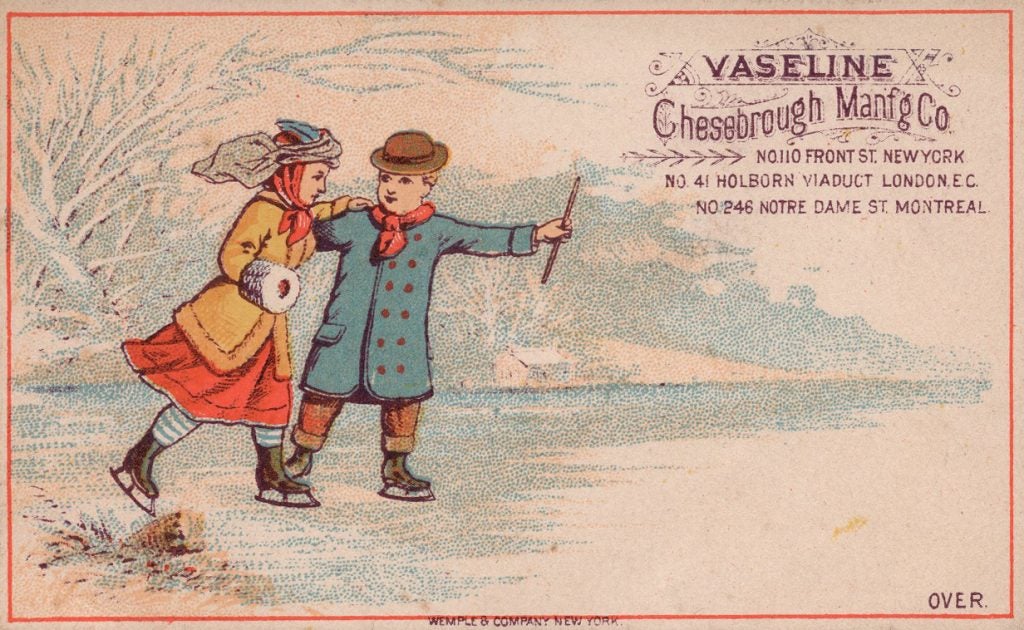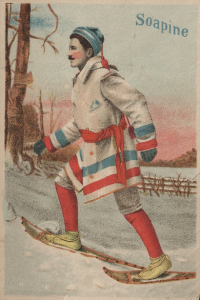From the Archivist: Winter Patent Medicine Trade Cards
With the arrival of colder weather, many people begin to feel under the weather. This time of year often brings back varying types of sicknesses, often due to the temperature change outside and the close proximity of people inside. Today, we can purchase over-the-counter medicines or visit the doctor for prescriptions, but in the nineteenth century, people had different options: patent medicine.
Patent medicine typically refers to drug mixtures created in the eighteenth and nineteenth centuries. Most of these recipes were not patented products, and often contained unknown ingredients, including alcohol, morphine, cocaine, and opium. Since the ingredients were not regulated, these medicines could be deadly and were not as effective as their advertisements declared.[1]
The Laupus Library’s History Collections has many Patent Medicine Trade Cards. Each advertises a product that claims to relieve a variety of maladies. For this post, I have selected three cards with a winter theme.
Vaseline
Most people are probably familiar with Vaseline, also known as petroleum jelly. First sold commercially in 1870, this product was patented by the United States just two years later. Chemist Robert Chesebrough invented Vaseline by using rod wax to create a petroleum concentrate (or jelly) with dry heat.[2] Chesebrough Manufacturing Company, whose name and address can be seen on the front of this card, produced Vaseline. Vaseline claimed to relieve Rheumatic pains, Asthma, colds, wounds, burns, and dry skin.[3]
Soapine
Some products were not meant for human ingestion, but instead served as household cleaners. Consumers purchased Soapine, the first soap powder, to clean laundry.[4] Manufactured and developed beginning in 1827 by Kendall MFG. Co. of Providence, Rhode Island, Soapine asserted that it worked “quicker, easier, cheaper and better than soap or anything else.” The reverse of this card states that Soapine is “for washing and cleaning everything, no matter what,” a statement the company took to the next level, including claims that it could wash Whales![5]
Lydia E. Pinkham’s Vegetable Compound
 The back of this trade card alleges that Lydia E. Pinkham’s Vegetable Compound is “a positive cure for all those painful complaints and weaknesses so common in our best female population.” Sold commercially by patent medicine proprietor, Lydia E. Pinkham beginning in 1875, the Vegetable Compound was a mixture of true unicorn root, pleurisy root, and contained 18 percent alcohol content! Pinkham privately developed the recipe years earlier before she commercialized it, but the Panic of 1873 created financial troubles for her family.[6] Consumers purchased the compound for all sorts of maladies, including headaches, depression, indigestion, backaches, and inflammation.
The back of this trade card alleges that Lydia E. Pinkham’s Vegetable Compound is “a positive cure for all those painful complaints and weaknesses so common in our best female population.” Sold commercially by patent medicine proprietor, Lydia E. Pinkham beginning in 1875, the Vegetable Compound was a mixture of true unicorn root, pleurisy root, and contained 18 percent alcohol content! Pinkham privately developed the recipe years earlier before she commercialized it, but the Panic of 1873 created financial troubles for her family.[6] Consumers purchased the compound for all sorts of maladies, including headaches, depression, indigestion, backaches, and inflammation.
Patent medicines began to disappear after the passage of the Pure Food and Drug Act in 1906, which regulated drug ingredients and allowed for public health action against unsafe materials.[7] Some manufacturers, like the Lydia E. Pinkham Medicine Co., continued to produce their remedies well into the 1920s, but reduced the products’ claims and alcohol content.[8]
For more information, contact History Collections, HSLHISTMED@ECU.ECU or (252)744-2235.
———————————————————-
[1] “History of Patent Medicines,” Hagley Museum and Library, accessed December 11, 2017, https://www.hagley. org/research/digital-exhibits/history-patent-medicine.
[2] “Chesebrough Manufacturing Company,” Cosmetics and Skin, last modified November 17, 2015, http://cosmeticsandskin.com/companies/chesebrough.php.
[3] Michael R. Albert MD, “Nineteenth-century Patent Medicines For the Skin and Hair,” Journal of the American Academy of Dermatology 43, no. 3 (September 2000): 524, http://www.sciencedirect.com/ science/article/pii/ S019096220078337X.
[4] William McLoughlin, Rhode Island: A History (States and the Nation) (New York: W.W. Norton and Company, Inc., 1986), 166.
[5] Dick Sheaff, “Whale Washing” last modified January 17, 2015, http://www.ephemerasociety.org blog/?p=2661.
[6] Encyclopaedia Britannica Online, s.v. “Pinkham, Lydia E,” https://www.britannica.com/biography/ Lydia-E-Pinkham (accessed December 11, 2017).
[7] “History of Patent Medicines.”
[8] “Pinkham, Lydia E.”

